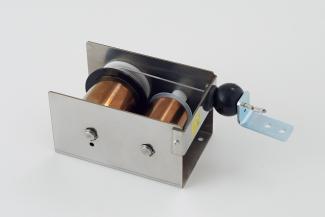CONSTON
CONSTON is a product name of the constant force spring that we have developed. CONSTON is a spring that can always offer a constant output regardless of whether it is pulled out or pushed, and even if the stroke is long.
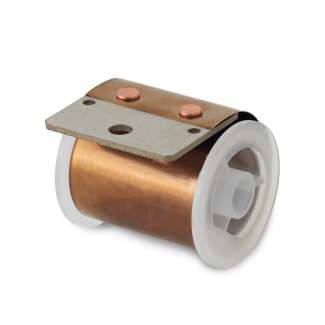
CONSTON is a product name of the constant force spring that we have developed.
CONSTON is a spring that can always offer a constant output regardless of whether it is pulled out or pushed, and even if the stroke is long.
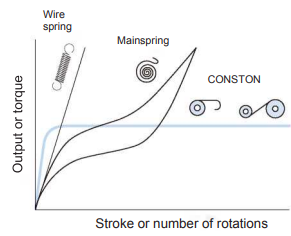
Features
- The output is unchanged even for a long stroke. The maximum output is obtained at the point where the CONSTON spring is pulled out by approx. a half or more turns from the drum.
- A long stroke is achieved in a small space. A wire spring requires its own space, but the CONSTON requires only a small installation space because the long spring fits in a small-diameter drum.
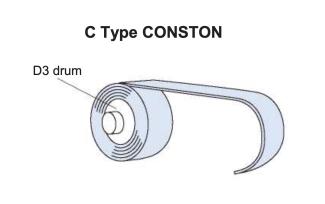
The C Type CONSTON is used by pulling out the CONSTON spring.Suitable for applications with guide rails.
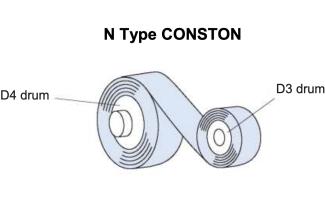
The N type CONSTON generates a rotational force and uses the tension that winds a wire and the like.Suitable for applications without guide rails because routing is possible with the wire.
Notes on selecting a spring
-
Even if the stroke of each standard product is larger than that to be used actually, no problem will occur with the specifications or the characteristics of the spring.
-
If the lineup does not include the specifications for your desired output, select an output that is stronger by one level. Adjust it by adding a balance weight to the mating load.
-
The products are basically intended for use at room temperature. Contact us for using a product at a lower or higher temperature.
Weight addition to main body
If the spring is to be attached with the end of the sub-plate or wire fixed (instead of fixing the bracket side (FIX in Figures 1 and 3 below)) so that the body can move along with W (Figures 2 and 4 below), select the spring output after adding the mass of the main body to that of W in the figure.
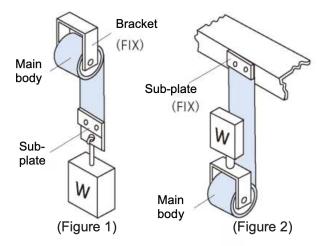
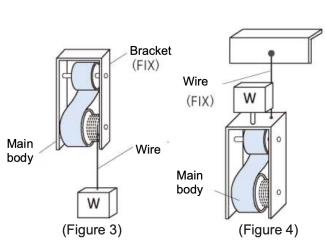
Usage Examples of CONSTON Constant Force Spring
Hanging a heavy object (balanceable)
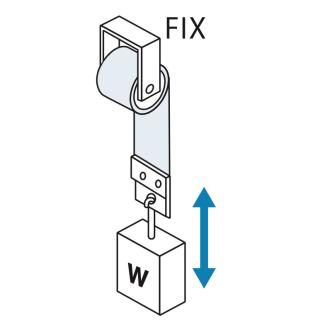
- Raising/lowering a window
- Raising/lowering a cycle rack
- Various types of balancers
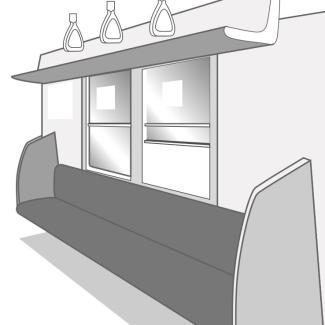
CONSTON allows you to raise/lower even a heavy window of the train with ease and stop it at any position.
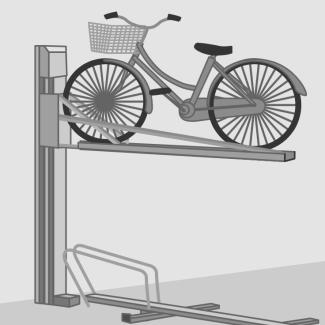
CONSTON is used to lift/lower a bicycle lightly. This helps to make effective use of the bicycle parking space.
Pushing up a heavy object (balanceable)
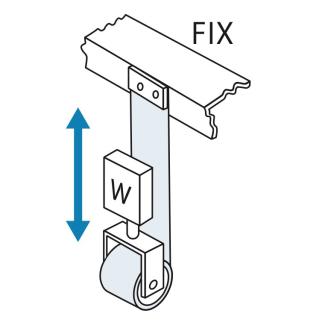
- Raising/lowering liquid crystal display
- Raising/lowering dental X-ray camera
- Raising/lowering height of fan

The use of CONSTONs allows adjusting the height of the bicycle to a position at which you can work easily.
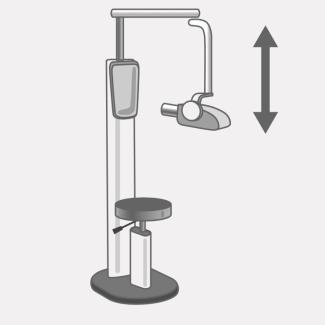
If you use a CONSTON for the heavy camera section, you can easily raise/lower it to the height at which you desire to take photos.
Winding it with a constant force (balanceable)
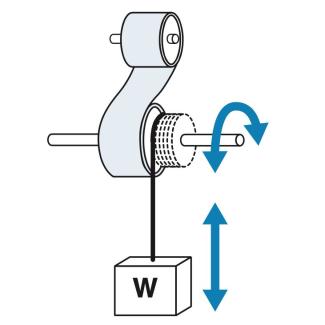
- Winding roll screen
- Tool balancer
- Raising/lowering pendant lighting

Shinkansen’s roll screen. The constant force enables to stop it at any position without a stopper.
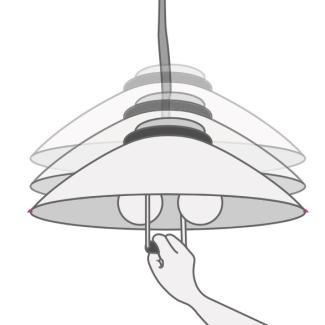
Balanced by the CONSTON, the height is adjustable to any position according to the ceiling height and the brightness.
Pushing and pulling it with a constant force
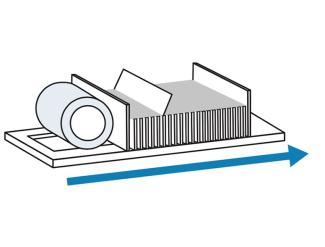
- Automatically feeding products forward
- Automatically opening a cup holder
- Parts feeder
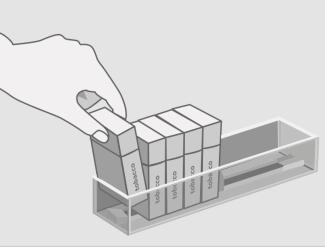
Cigarette packs are always placed at the front because the CONSTON can automatically push them forward. CONSTON springs are also available for various products other than cigarette packs.
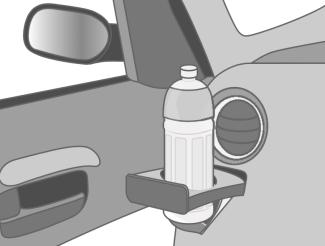
Used as the power source for the one-push opening mechanism of cup holders in cars. Since the spring can push it out to the end with a constant force, thesmooth operation can give a sense of quality.
Types and General Usage of CONSTONs
C Type CONSTON
This is the most commonly used type. When the CONSTON is pulled out, a force acts in the direction (←) to return to the original shape. This returning force is utilized.
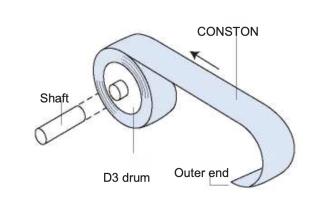
N Type CONSTON
The CONSTON is used as the rotational force source. Pull out the CONSTON spring wound up around the smaller drum, D3, and fix it to the larger drum, D4, with its front and back reversed. If the CONSTON spring is released after being wound around the D4 drum, the spring will generate a force in the direction of the arrow (→) to return to the D3 drum. The rotational force can be obtained by rotating the D4 drum with this force.
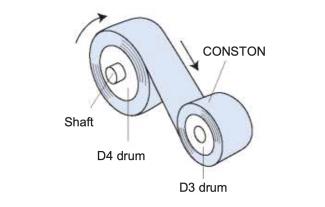
O Type CONSTON
The original form of the CONSTON is the same as the C Type CONSTON, but by using the two drums, it can be used as a cover for being wound to the left and right.
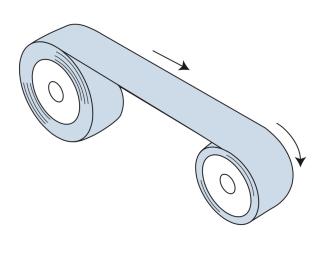
Product life of CONSTON
When the designed life has been reached, the CONSTON’ force decreases due to some effects such as cracks produced in the spring. If it is continued to be used after this, the cracks will gradually grow and the spring will eventually break.
(The life cycle value of each product is only for reference.)
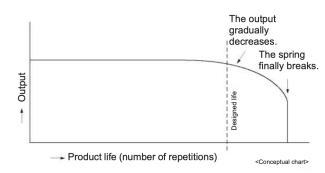
Custom-Made Products
CONSTONs can be designed according to space.
The power and torque of each CONSTON is determined by a combination of material thickness, width, and diameter; we design it according to space.
When ordering a custom-made product, please let us know about the following:
-
Applications
-
Installable space
-
Required output (N) or torque (mN·m)
-
Operating environment (e.g. temperature, humidity, vibration, and shock)
-
Working stroke (or number of rotations)
-
Production quantity and set length
-
Life (number of repetitions)
Relationship among the output, dimensions (width and diameter), and life of a CONSTON
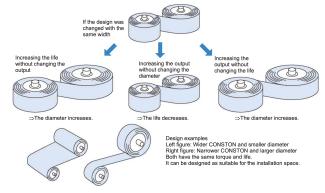
CONSTON units
CONSTON springs are often used as a unit combined with other parts, rather than being used alone. We will also consider the unitization. Please feel free to contact us.
C Type CONSTON Unit
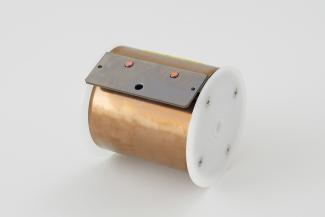
N Type CONSTON Unit
